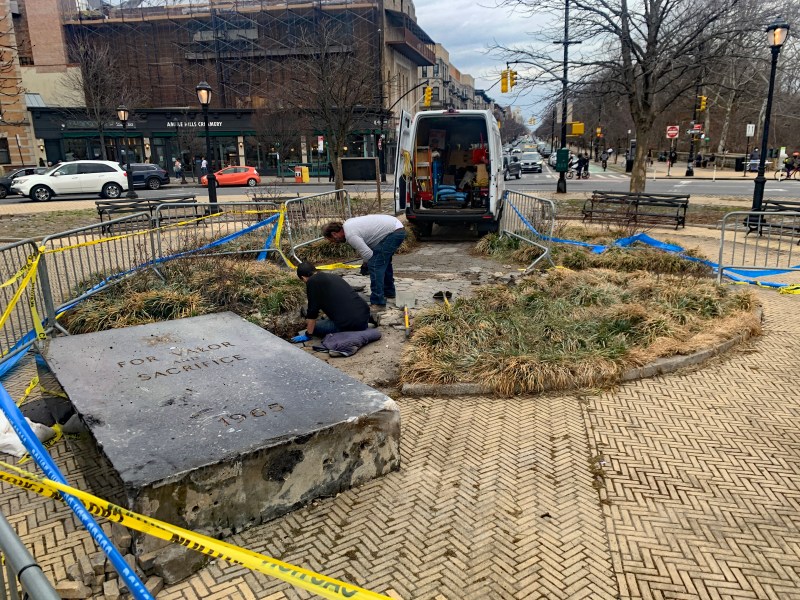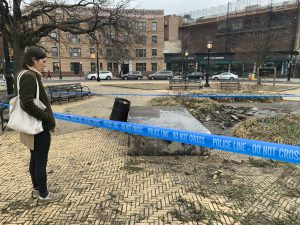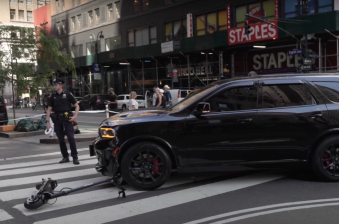AW, SHUCKS: Driver in Explosive War Monument Crash with 120 Tickets Was Almost About to be Held Accountable

Well, the system almost worked!

The driver of the Texas-plated BMW who smashed into Park Slope’s beloved war memorial early on Sunday morning had been sent a warning letter by the Department of Transportation demanding that he or she attend one of the agency’s mandated safety classes because he or she had been caught on camera speeding and running red lights roughly 120 times in a year — but the driver had until late May to take the course before facing the risk of having the car impounded.
The point is now moot, given that the driver totaled the fancy sedan in the early morning crash — slamming it against a heavy stone monument and running away as the car burst into flames and was rendered inoperable. Now there’s no risk to the driver of having the car impounded for failing to take the safety course: the car is unusable anyway.
In the wake of the crash, many New Yorkers are asking how the owner of this car was even allowed behind the wheel. The better question is actually how the city manages to get any reckless drivers off the street.
The first part of the equation is that camera-issued tickets are assessed against cars, not people. As such, automated tickets do not count against any driver’s record in the way that police-issued tickets are. A police-issued speeding ticket, for example, adds three or more violation points on a driver’s record, and a driver’s license is suspended if he or she gets 11 points in an 18-month period. (New York City speed cameras kick in whenever a driver is exceeding a posted speed limit by 11 miles per hour or more, a ticket that would be worth four points. So just three camera tickets would trigger a suspension if they counted as points.)
This particular BMW sedan entered the city ticket database on Jan. 14, 2021 with a camera-issued school zone speeding ticket at Linden Boulevard and Vermont Street. Since that ticket, the car was caught on camera 109 more times in the next 12 months and 26 days — 95 for speeding and 20 times for running red lights. Virtually all of the tickets were caught on cameras near the location of the first ticket.
This does not seem to be a driver who ranges very far. Of the 145 moving violations and parking tickets assessed against this car, only about a dozen were far away from that original ticket.
One flaw of the city’s effort to hold drivers accountable is that if drivers keep paying their tickets, they never risk having their car impounded for non-payment of tickets. But in this case, the driver already has $601.79 in tickets that have been ruled overdue (or as the city calls it “in judgment”). The city can impound any car that has more than $350 in tickets ruled “in judgment”).
The driver has another $4,795 in unpaid tickets that have not been ruled “in judgment” yet. The driver has paid some tickets over the last 12 months, but very few.
And yet the car was never impounded. Why?
For one thing, it’s hard to find scofflaw cars on the streets of New York. Last year, after the driver of a Pennsylvania-plated car crashed into another driver and then killed a 3-month-old girl, officials revealed that their license plate scanning system never “saw” the car on the street — meaning it might have been parked off the street or simply that it’s a big city.
But the Texas-plated car that blew up after striking the “For Valor and Sacrifice” monument was hardly invisible to the city. In fact, after it was ruled in judgment in November, 2021, city ticket agents encountered the car at least eight times:
- On Nov. 1, 2021, a traffic agent named D. Miller slapped a ticket on the car for parking in a bus lane.
- On the same day, a traffic agent named H. Hernandez caught this car for a no-standing violation in Downtown Brooklyn.
- On Nov. 21, 2021, a police officer named Belfon slapped a ticket on the car for parking in a crosswalk.
- On the same day, a traffic agent named J. Williams ticketed the car for parking in a bus stop.
- On Jan. 13, 2022, a traffic agent named A. Hossain ticketed the car for parking in a bus lane.
- On Jan. 23, 2022, a police officer named Gomez ticketed the car for parking in a bus stop.
- On Feb. 3, 2022, a traffic agent named J. Dail ticketed the car for parking in a no stopping zone.
- On Feb. 7, 2022, a traffic agent named A. Mshahl ticketed the car for parking in a bus stop.
Any one of those ticketing agents could have alerted authorities to the location of the car of a recidivist scofflaw that was already in judgment. Yet the city failed to get this car off the road.
That raises the question of whether out-of-state-plated cars present a larger problem to the city.
At an unrelated City Council Transportation Committee hearing on Monday, the DOT dropped a bit of a bombshell of a statistic: 40 percent of speed camera violators have vehicles registered outside the City of New York.
No more details were presented, but the statistic connects nicely horrifyingly with two prior Streetsblog investigations. In September, we reported that roughly 17 percent of vehicles involved in crashes in the city since 2019 had out-of-state plates. An even higher portion of cars involved in fatal city crashes — 20 percent — had non-New York plates.
And in October, we reported that drivers of out-of-state-plated cars owe the city hundreds of millions of dollars in unpair summonses. Out-of-state-plated cars can park for free on city streets … just like virtually every car.
Complicating matters is just how badly the NYPD has handled this particular case — at least in its public pronouncements. According to the agency, when cops showed up, there were two people on the scene — a woman who was injured and was taken to Lutheran Hospital and a man who was uncooperative and declined medical attention. Police believe that a third person — the driver with the horrendous record — fled before they arrived.
The NYPD has declined to provide any more information, which has prompted a wide variety of theories among residents of the neighborhood. Officially, the agency says the investigation is ongoing.
The one bright spot — and it is the most ephemeral of bright spots — is that on Feb. 1, the driver had been mailed a notice that he or she was required — by dint of having more than 14 school zone speeding tickets or five camera-issued red light tickets in 12 months — to a city safety course created by the Dangerous Vehicle Abatement Act, which passed in early 2020, but was not funded until 2021 (and not implemented until late that year).
Thousands of drivers already meet the 15-or-five threshold, but only 134 people have taken the course, according to the DOT. Another 18 are schedule this month, part of a cohort of just 400 people who have received notices overall.
The driver of the flaming BMW was supposed to respond to the city class notice by March 17, which hadn’t come yet. If he or she failed to respond, the city provides another 45 days before beginning the impound process, which requires a hearing.
Since this one dangerous vehicle has been abated by the crash, it’s unclear if this driver will start with a clean slate.
The Department of Finance did not get back to us by our 5 p.m. deadline.



